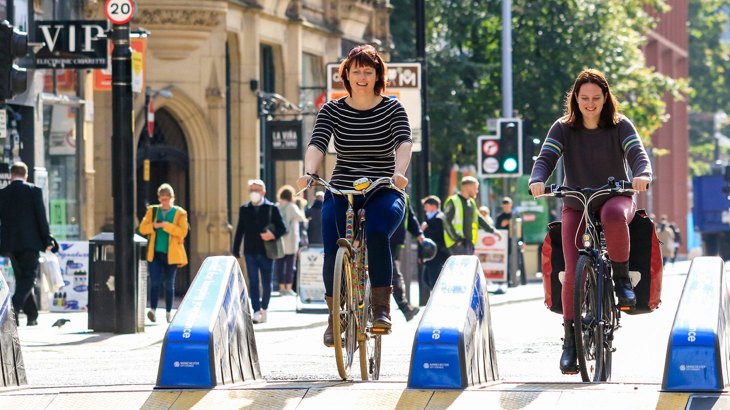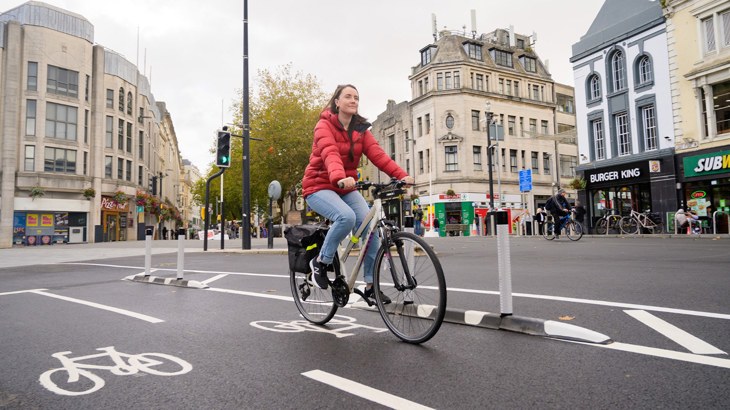Cities and towns are making changes to streets and places faster than ever before in response to Covid-19. But these schemes are also creating public backlash and facing opposition. Our Senior Policy and Partnerships Advisor, Tim Burns explains how we can prepare for this backlash and manage local opposition.

Cities and towns are making changes to streets and places faster than ever before in response to Covid19 to increase space for walking, cycling.
With walking rates already high, and cycling increasing in many parts of the UK these changes are welcome for many people.
However, these schemes also create public backlash and opposition, as change can be scary for people, especially during a time of crisis. Responses are often polarised and then populated via the media.
This blog is written for anyone involved in making these changes happen, especially members and officers of local authorities who are leading these schemes and often feeling the sharp end of local opposition.
We owe you our thanks
Firstly, we need to share our thanks. Your work over the past six months and swift action to implement street changes in response to the pandemic has been extraordinary.
These changes taking place are not just relevant to Covid-19 but also to how we make cities and towns more liveable and equitable.
Much of the work achieved this year has the potential to be a catalyst for changing the speed and the way we improve our neighbourhoods in the future.
Faced with the climate crisis and a crisis of health inequality, delivering change is critical and needs to happen quickly.
After many years of designing our cities, towns and villages solely for cars, we are at a tipping point where finally the government and many people are beginning to realise this is far from ideal.
However, in helping to deliver this change, we also need to be inclusive to all people, especially those who are often dependent upon motor vehicles, not through choice, but through circumstance and years of car-centric planning.
Opposition is inevitable – but we need to be better prepared for it
People are always going to be sceptical of changes made to their neighbourhoods and streets, especially when it is likely to affect how they get around.
In the face of this, opposition is inevitable.
It shows that the changes being made are important enough for people to care. And people do care on both sides of the debate about how our streets and neighbourhoods should be designed and function.
Of course, most people sit in the middle of this. They see the benefits of reduced rat-running and having safer, quieter and cleaner streets.
However, people might also have concerns that schemes could make journeys they make more awkward or increase traffic levels.
All of these reactions are normal and we need to be better prepared to manage opposition, especially, as many examples show, once people get used to changes opposition tends to decline. In these challenging times, leaders must show leadership and give street changes more time.

© Jon Bewley
Six recommendations for managing backlash
1. Engage with residents
When getting schemes moving on the ground, engage with residents and other stakeholders to communicate what is happening, why it is needed and paint a vivid picture of the potential benefits.
Proactively reaching out to local residents and businesses is critical before any schemes are delivered.
Residents need to know what is planned and how changes will help improve their area and lives – quieter streets, better air quality, and a safe space to play for children. They also need to know if these changes are a trial, how to suggest recommendations, and how and improvements will be made.
Work with emergency services, and reach out to disability groups to ensure access remains for those who need it most.
Throughout the trial period residents and businesses need to be given an opportunity to provide feedback. This should be easy to do and inclusive for everyone. If required, changes should be made during the trial process as well as at the end.
2. Show people examples of success
We need to share success and show how things can be done well with positive outcomes in easy to understand ways - video and photography are important.
Crucially important in the approach to handling objections and responding effectively to user feedback is identifying and using local advocates – local residents and local businesses are important in this process.
On Northcote Road in Wandsworth, a weekend pedestrianisation scheme was so successful for local businesses, it led to 58 jobs being de-furloughed, and 45 new jobs for people.
3. Demonstrate that you’re empathetic to local views, including businesses
Right now so many uncertainties are present across our lives. We are in the midst of the second wave of the pandemic and facing further local and stricter lockdowns.
At the same time, unemployment is rising, greater anxiety exists, public transport capacity is reduced, therefore reducing accessibility for many people and we are all adjusting to new routines and ways of living.
It is more important than ever to listen and take account of different views and opinions, and to make sure that people hear the range of views their fellow residents and workers hold.
Businesses, for example, have seen huge economic challenges this year and are genuinely concerned about closing their streets to cars or removing parking spaces.
Most retailers, cafes and restaurants understand and believe that being on a nicer street with more space for people could bring more and new customers to their shop. However, in these uncertain times, it’s a gamble and more uncertainty is hard to manage.
Working with economic development teams to listen to concerns, and find a range of solutions to help with business recovery, some that may have nothing to do with walking, cycling or vehicle use, may help with this.
Sharing back results of surveys, or providing anonymised quotes about a controversial scheme, can help remind people that there is a range of opinions.
4. Collect data
When work started on the Mini-Holland scheme in Waltham Forest, 44% of residents were opposed. Five years on, just 1.7% of residents would scrap the scheme, according to council surveys.
It takes time sometimes for people to get used to changes and opinions can change over time. We currently have a shortage of robust evidence of many of the changes taking place.
For example, what level of support and opposition exists from the community and not just those who are vocal? How effective are the schemes in relation to our objectives? Are there any changes required to improve their design?
If we don’t have the evidence to back up many of these questions, the measures introduced in 2020 and the ambition to continue in 2021 will dissipate.
Right now it is vital that local authorities are robustly monitoring schemes taking place. We might just be on the verge of a tipping point in the UK where we create towns and cities that put people first, however, we must demonstrate both the benefits and support for these schemes.
5. Improve appearance and design
As we move from trial to more permanent schemes, improving the appearance of what is designed as well as its functionality is important.
Many of the best schemes are places people want to be. Plastic crash barriers intended to increase pavement space worked as a ready-made solution earlier this year, but make high streets look like race tracks and spoil the overall appearance of the street. They also move around and become less safe without adequate maintenance.
Places need to be welcoming and have character. Designing places people want to hang out with the inclusion of planters, seating areas, and pocket parks are important.
Dundee’s Union Street was closed to traffic in July. The scheme includes on-street wooden seating areas for restaurants and bars.
It was co-designed with businesses and residents and an artist developed a mural as a centrepiece for the scheme. 84% of traders say that the changes have been positive for the street, with 62% saying it has been good for their business.
Sometimes data may demonstrate that schemes aren’t working and that they do need to be taken out. If this is the case, don’t be afraid to do so – what you learn from the experience also matters.
6. Give street changes time whilst listening to feedback
Across the UK we are used to long, drawn-out consultations, processes and legal challenges when changing the urban environment and road space.
The trial schemes that have been introduced this year had to be delivered quickly in response to the pandemic has changed everything. Many of them have been implemented first with formal consultation taking place afterwards.
This has a number of significant advantages – people can experience and see the changes for themselves. People still need to be engaged before schemes are implemented and need to know that these are trials and that their local authority values their feedback.
Do take the opportunity to engage really early with those who are more vulnerable to changes to streets and spaces, well before formal consultation to ensure that you end up with better quality designs.
As most things have gone in quickly there are likely to be teething issues. This means listening to feedback and often making refinements to improve them. Responding to requests and suggestions to make them work better for everyone is vital.
Consulting retrospectively could be an opportunity to speed up changes in the future and respond more quickly to issues like the climate crisis. However, they will not be correct for every scenario and must always still be fair.
Final thoughts
We urge councils facing opposition not to abandon their plans to make our streets better for people and reduce car traffic.
Safer and more inclusive streets and places for everyone are vital not just during the pandemic but for the health and wellbeing of people across the UK.
Many local leaders are currently facing significant pressure. If you would like to share any lessons you have learnt, over the past six months and before, to manage opposition and improve schemes for everyone we would love to hear from you and help others.
Please contact your nearest Sustrans office to share what you've learnt.
Take a look at our guide to low traffic neighbourhood design.





